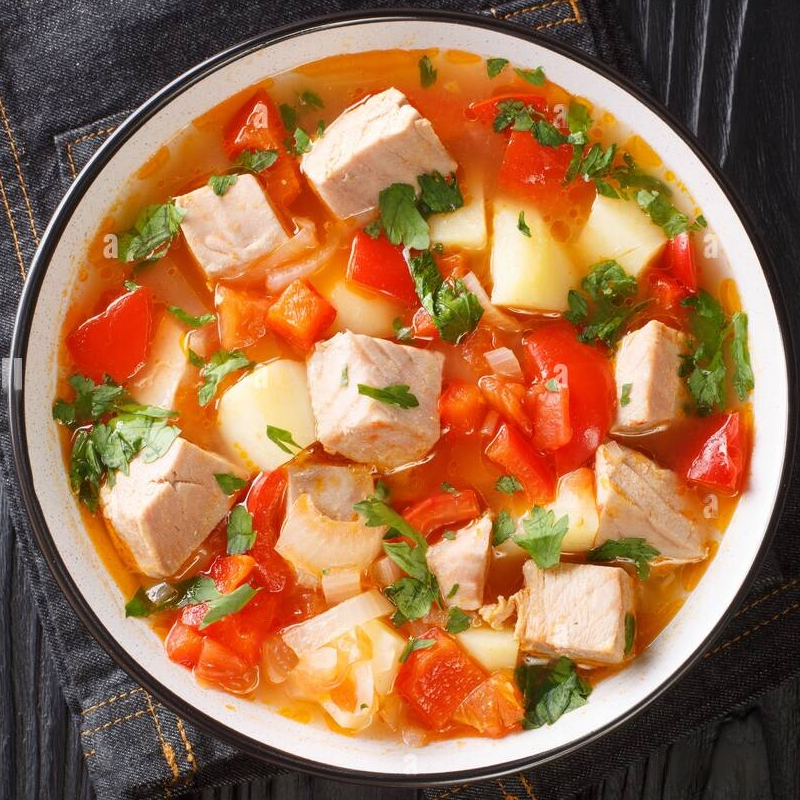Marmitako (probable 17th-18th century version)
 Garanties sécurité
Garanties sécurité
(à modifier dans le module "Réassurance")
 Politique de livraison
Politique de livraison
(à modifier dans le module "Réassurance")
 Politique retours
Politique retours
(à modifier dans le module "Réassurance")
Marmitako (probable 17th-18th century version)
The Origin of Marmitako
Marmitako is a traditional dish from Basque cuisine, especially associated with the fishermen and sailors of the Gulf of Gascony. Its name comes from the tool used to prepare it: the marmita, a large metal pot in which fishermen cooked their meals after a long day at sea. This dish came about out of necessity, in a context of frugal cooking, using the simplest and most accessible ingredients of the time: fish, potatoes, vegetables, and sometimes a few herbs.
History and Origins
The origin of marmitako dates back to the ancient Basque fishermen who, at sea, often relied on basic resources to feed the crew. White tuna, abundant in the Gulf of Gascony, was the preferred fish. Other ingredients, such as potatoes, onions, and peppers, were common local products, grown or obtained during stops. The dish consisted of a mix of vegetables and fish cooked in a single pot, hence its name. This simple and robust cooking method became a culinary tradition.
The First Recipes of Marmitako
The first recipe for marmitako could be found in the kitchens of fishermen, but with local variations and adjustments based on available ingredients. As the dish spread, it became enriched and codified. At the time, it was not yet a sophisticated recipe, but rather a rudimentary preparation designed to feed sailors after a hard day of work at sea.
Primitive Recipe of Marmitako (probable 17th-18th century version)
Here is a reconstruction of what the primitive recipe of marmitako might have looked like, following the simple principles of the time:
Ingredients:
- 500 g of white tuna (or any other local fish, such as mackerel or whiting if tuna wasn't available)
- 4 medium potatoes
- 2 medium onions
- 1 green pepper
- 1 tomato (or a little tomato paste, though it wasn't systematically used originally)
- 1 garlic clove
- 1 liter of water (or fish stock if available)
- Olive oil for cooking
- Salt and pepper to taste
- A few sprigs of parsley (optional)
Preparation:
-
Prepare the ingredients:
- Peel and cut the potatoes into cubes.
- Finely chop the onions and garlic.
- Cut the pepper into pieces.
- If using a tomato, score it in a cross pattern and plunge it into boiling water to remove the skin, then chop it.
-
Cook the vegetables:
- In a large pot, heat some olive oil.
- Add the onions and garlic and sauté until tender and lightly golden.
- Add the pepper and tomato (or tomato paste), and cook for a few minutes until the tomato breaks down.
-
Add the potatoes:
- Add the cut potatoes to the pot and mix well with the other vegetables.
- Pour in water (or fish stock if available) to cover the vegetables.
- Cook over medium heat for about 20 to 30 minutes, until the potatoes are tender.
-
Cook the fish:
- Meanwhile, cut the tuna into large chunks. You can marinate it a little with salt, pepper, and olive oil, but this was not common in the primitive versions.
- Once the potatoes are almost cooked, add the fish to the pot and cook for 10 to 15 minutes, or until the fish is fully cooked and tender.
-
Finish and serve:
- Taste and adjust the seasoning with salt and pepper as needed.
- Serve hot, garnished with fresh parsley if desired.
Notes:
- This dish did not require a wide variety of ingredients, and the idea was to use what the fishermen had on hand.
- In the earliest versions of marmitako, it is likely that tomatoes were not always used, and the dish was sometimes more simple with fewer vegetables.
- Everything was cooked in a single pot, which made for a simple and quick preparation.
Evolution of Marmitako
Over time, marmitako evolved, influenced by available ingredients and local culinary culture. Peppers, tomatoes, and sometimes even chili were introduced in more modern versions of the dish. The fish used also varied depending on local preferences and seasons, but tuna remains the traditional choice.
Conclusion
Marmitako is a perfect example of survival cooking and the simplicity of the past, yet it remains an iconic dish in Basque gastronomy, honoring the culinary heritage of the fishermen of the Gulf of Gascony. The transition from the traditional dish to its modern version shows how recipes evolve while staying true to their roots, uniting history and flavors.


